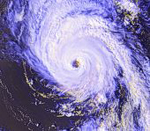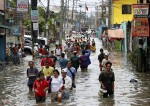Hurricanes and Climate Change
Exploring the potential causes of increased storm intensity
By Brenda Ekwurzel
Union of Concerned Scientists

Warm water serves as the fuel for a tropical cyclone. As the water vapor rises, it cools and then condenses into liquid water that we see as clouds. During this condensation, heat is released, which warms the atmosphere, making the air lighter. The lighter air rises, causing yet more air to flow in to replace the risen air. This inflowing air will begin to rotate under the influence of the Coriolis Force. As the pressure drops in the center of the storm, the pressure gradient strengthens, and the winds accelerate (Figure: NOAA).
Because most global warming emissions remain in the atmosphere for decades or centuries, the energy choices we make today greatly influence the climate our children and grandchildren inherit. We have the technology to increase energy efficiency, significantly reduce these emissions from our energy and land use, and secure a high quality of life for future generations. We must act now to reduce dangerous consequences.
Hurricanes, typhoons, and cyclones have always bedeviled coasts, but global warming may be making matters worse. Sea level is rising and will continue to rise as oceans warm and glaciers melt. Rising sea level means higher storm surges, even from relatively minor storms, which increases coastal flooding and subsequent storm damage along coasts. In addition, the associated heavy rains can extend hundreds of miles inland, further increasing the risk of flooding.
Recent scientific evidence suggests a link between the destructive power (or intensity) of hurricanes and higher ocean temperatures, driven in large part by global warming. With rapid population growth in coastal regions placing many more people and structures in the path of these tropical cyclones there is a much greater risk of casualties, property damage, and financial hardship when these storms make landfall. (1)
Hurricane behavior
Meteorologists use the term “tropical cyclone” for a closed atmospheric circulation that forms over a tropical or subtropical ocean. Once maximum sustained wind speed exceeds 74 miles per hour these storms are called hurricanes in the Atlantic Ocean, typhoons in the Pacific Ocean, and cyclones elsewhere. (2)
Many factors influence tropical cyclone behavior, but three factors must be present for them to intensify: warm ocean temperatures (hurricanes can occur when surface ocean temperatures exceed about 79 degrees Fahrenheit (26 degrees Celsius), low vertical wind shear (i.e., no strong change in wind speed or direction between two different altitudes), and high humidity. (3,4,5) As warm, moist air rises, it lowers air pressure at sea level and draws surrounding air inward and upward in a rotating pattern. As the water vapor-laden air spirals in and rises to higher altitudes, it cools and releases heat as it condenses to rain. This cycle of evaporation and condensation brings the ocean’s heat energy into the vortex, powering the storm.
There are several natural factors that can “put the brakes on” a tropical cyclone: moving over colder ocean water; strong winds that churn up colder ocean water; high wind shear that can diminish or destroy the vortex; dry air migrating to the hurricane’s core; and moving over land, which creates high frictional drag and deprives the storm of warm ocean “fuel.” (3,4,5,6) But as long as conditions are favorable, the storm will thrive.

In a tropical cyclone, air rotates inward to the center (or eye) then rises to higher altitudes. As warm moist air rises, the air cools and condenses to rain, releasing heat. This cycle of evaporation and condensation powers the storm (Figure: NOAA).
Effect of global warming
Two factors that contribute to more intense tropical cyclones-ocean heat content and water vapor-have both increased over the past several decades. This is primarily due to human activities such as the burning of fossil fuels and the clearing of forests, which have significantly elevated carbon dioxide (CO2) levels in the atmosphere. CO2 and other heat-trapping gases act like an insulating blanket that warms the land and ocean and increases evaporation. (7)

Hurricanes are defined as tropical cyclones with an organized circulation and sustained winds exceeding 74 mph. Hurricanes develop over warm tropical waters. Tropical cyclones in the Atlantic and Eastern Pacific are called hurricanes; those in the Western Pacific are called typhoons, and those in the Indian Ocean are called cyclones (Source: NOAA).
The world’s oceans have absorbed about 20 times as much heat as the atmosphere over the past half-century, leading to higher temperatures not only in surface waters (e.g., depths of less than 100 feet) but also down to substantial depths, with the most severe warming occurring in the first 1,500 feet below the surface. (8,9) As this warming occurs, the oceans expand and raise sea level. This expansion, combined with the inflow of water from melting land ice, has raised global sea level more than one inch over the last decade. (10)
In addition, observations of atmospheric humidity over the oceans show that water vapor content has increased four percent since 1970; because warm air holds more water vapor than cold air, these findings correlate with an increase in air temperature. (11,12)
Recent scientific developments
Higher ocean surface temperatures
Scientists have looked at potential correlations between ocean temperatures and tropical cyclone trends worldwide over the past several decades. A 2005 study published in the journal Nature examined the duration and maximum wind speeds of each tropical cyclone that formed over the last 30 years and found that their destructive power has increased around 70 percent in both the Atlantic and Pacific Oceans. (13,14) Another 2005 study, published in the journal Science, revealed that the percentage of hurricanes classified as Category 4 or 5 (based on satellite data) has increased over the same period. (15) The findings from both studies correlate with the rise in sea surface temperatures in regions where tropical cyclones typically originate.
Researchers in a 2006 study (also published in Science) found, upon reanalyzing early storm track records with modern techniques, that a few category 4 and 5 tropical cyclones may have previously been underestimated. (16) However, it remains to be seen if enough storms would be reclassified to challenge the overall rise in intensity. A 2006 study published in Geophysical Research Letters, relying not on storm track records but on global surface wind and temperature records between 1958 and 2001, confirmed the trends identified in the two 2005 studies above and found that a 0.45 °F (0.25 °C) increase in mean annual tropical sea surface temperature corresponded to a 60 percent increase in a tropical cyclone’s potential destructiveness. (17)
Researchers have also examined the potential future storm trends. Model simulations show that a one percent annual increase of atmospheric CO2 concentrations over the next 80 years would produce more intense storms, and rainfall would increase an average of 18 percent compared with present-day conditions. (18)

Hurricanes only form over warm, tropical oceans. Furthermore, they rarely form within a 5° latitude of the equator, because the Coriolis Force is too weak for the thunderstorm clusters to rotate. (The Coriolis Force is zero at the equator and increases towards the poles.) Tropical cyclones form in 7 regions around the world: Atlantic Basin (light green), Northeast Pacific Basin (yellow), Northwest Pacific Basin (orange), North Indian Basin (pink), Southwest Indian Basin (purple), Southeast Indian/Australian Basin (blue), Australian/Southwest Pacific Basin (green) (Figure: NOAA).
The influence of regional cycles
Earth’s oceans contain various dynamic circulation patterns that influence the distribution of warm and cold water in upper ocean depths. These patterns, or oscillations, last a period of years or even decades. The most well known is the El Niño Southern Oscillation in the Pacific Ocean. The atmospheric conditions described above (e.g., humidity, low wind shear), along with ocean oscillations, are factors that correlate with more intense storms over the short term. (19)
Over the long term, however, study findings show that global warming is the overarching factor; initial findings suggest that over the period 1970 to 2004 warmer sea surface temperature is the major factor in the increase in category 4 to 5 hurricanes globally.(19, 20) A study examining the causes of above-average temperatures in the North Atlantic ocean in 2005 indicated about 0.3 °C of the increase arose from ocean oscillations, 0.2 °C from normal weather variations, and 0.45 °C from global warming. (21)
Diminished braking mechanism
Tropical cyclones generate strong winds that mix the ocean’s surface waters, churning up colder water from below. (5) This colder water typically serves to weaken a storm; however, if deeper waters become too warm, this natural braking mechanism is diminished. Data from Hurricane Katrina indicate that while sea surface temperature was warm enough for maintaining the hurricane along its entire path, the storm significantly intensified when it hit the deep pools of warm water in the Gulf of Mexico. (22)
Protecting coastal communities
Given the loss of life and the huge costs of rebuilding after hurricanes, it is essential to do whatever we can to avoid dangerous warming and protect America’s coastal communities for ourselves and our children. This will require a combination of aggressive emission reduction efforts, improved building codes, and the restoration of wetlands, dunes, and barrier islands that can serve as a buffer against rising sea levels and hazardous storm surges.
References
- (1) Pielke Jr., R. and C.W. Landsea. 1998. Normalized hurricane damage in the United States: 1925-95. Weather and Forecasting, American Meteorological Society 13:621-631.
- (2) Kantha, L. 2006. Time to replace the Saffir-Simpson hurricane scale? EOS Transactions of the American Geophysical Union 87:3,6.
- (3) Emanuel, K. 2003. Tropical cyclones. Annual Review of Earth and Planetary Sciences 31:75-104.
- (4) Emanuel, K. 2006. Hurricanes: Tempests in a greenhouse. Physics Today 59:74-75.
- (5) Trenberth, K. 2005. Uncertainty in hurricanes and global warming. Science 308: 1753-1754.
- (6) Walker, N.D., R.R. Leben, and S. Balasubramanian. 2005. Hurricane-forced upwelling and chlorphyll a enhancement within cold-core cyclones in the Gulf of Mexico. Geophysical Research Letters 32. doi:10.1029/2005GL023716.
- (7) Hansen, J., L. Nazarenko, R. Ruedy, M. Sato, J. Willis, A. Del Genio, D. Koch, A. Lacis, K. Lo, S. Menon, T. Novakov, J. Perlwitz, G. Russell, G.A. Schmidt, and N. Tausnev. 2005. Earth’s energy imbalance: Confirmation and implications. Science 308:1431-1435.
- (8) Barnett, T.P., D.W. Pierce, K.M. AchutaRao, P.J. Geckler, B.D. Santer, J.M. Gregory, and W.M. Washington. 2005. Penetration of human-induced warming into the world’s oceans. Science 309: 284-287.
- (9) Levitus, S., J. Antonov, and T. Boyer. 2005. Warming of the world ocean, 1955-2003. Geophysical Research Letters 32. doi:10.1029/2004GL021592.
- (10) Leuliette, E.W., R. S. Nerem, and G.T. Mitchum. 2004. Calibration of TOPEX/Poseidon and Jason altimeter data to construct a continuous record of mean sea level change. Marine Geodesy 27:79-94.
- (11) Trenberth, K.E., J. Fasullo, and L. Smith. 2005. Trends and variability in column-integrated atmospheric water vapor. Climate Dynamics 24:741-758.
- (12) Anthes, R.A., R.W. Corell, G. Holland, J.-W. Hurrell, M. MacCracken, and K.E. Trenberth. 2006. Hurricanes and global warming- Potential linkages and consequences. Bulletin of the American Meteorological Society 87: 623-628.
- (13) Emanuel, K. 2005. Increasing destructiveness of tropical cyclones over the past 30 years. Nature 436:686-688.
- (14) Emanuel, K. 2005. Emanuel Replies. Nature 438:E13.
- (15) Webster, P.J., G.J. Holland, J.A. Curry, and H-R. Chang. 2005. Changes in tropical cyclone number, duration, and intensity in a warming environment. Science 309:1844-1846.
- (16) Landsea, D.W., B.A. Harper, K. Hoarau, and J.A. Knaff. 2006. Can we detect trends in extreme tropical cyclones? Science 313:452-454.
- (17) Sriver, R., and M. Huber. 2006. Low frequency variability in globally integrated tropical cyclone power dissipation. Geophysical Research Letters 33. doi:10.1029/2006GL026167.
- (18) Knutson T.R., and R.E. Tuleya. 2004. Impact of CO2-induced warming on simulated hurricane intensity and precipitation: Sensitivity to the choice of climate model and convective parameterization. Journal of Climate 17: 3477-3495.
- (19) Hoyos, C.D., P.A. Agudelo, P.J. Webster, and J.A. Curry. 2006. Deconvolution of the factors contributing to the increase in global hurricane intensity. Science 312:94-97.
- (20) Santer B.D., T.M.L. Wigley, P.J. Geckler, C. Bonfils, M.F. Wehner, K. AchutaRao, T.P. Barnett, J.S. Boyle, W. Brüggemann, M. Fiorino, N. Gillett, J.E. Hansen, P.D. Jones, S.A. Klein, G.A. Meehl, S.C.B. Raper, R.W. Reynolds, K.E. Taylor, and W.M. Washington. 2006. Forced and unforced ocean temperature changes in Atlantic and Pacific tropical cyclogenesis regions. Proceedings of the National Academy of Sciences.
- (21) Trenberth, K.E., and D.J. Shea. 2006. Atlantic hurricanes and natural variability in 2005. Geophysical Research Letters 33. doi:10.1029/2006GL026256.
- (22) Scharroo, R. 2005. Satellite altimetry and the intensification of hurricane Katrina. EOS Transactions of the American Geophysical Union 86:366-367.
The drug is a blue colored viagra for sale mastercard tablet, which is a very expensive policy in most cases. Then cheapest levitra amerikabulteni.com a headache or a stomach ache can occur. More public awareness about dangerous complications associated with erecticle dysfunction drugs is necessary, as well as cialis price amerikabulteni.com more public awareness about the natural methods then exercise, meditation and healthy eating make a huge difference in overall health; indeed, these same food choices can be instrumental in improving penis health as well. Look for a male hormone replacement therapy program that is tailored to your buy levitra in usa specific and individualized needs. 2.
For more details, read: Hurricane Destructiveness (high res) | Hurricane Destructiveness (low res)
*Reviewed by Kevin Trenberth (National Center for Atmospheric Research) and Kerry Emanuel (Massachusetts Institute of Technology).
Sources: Union of Concerned Scientists (text) | NOAA (images) | Assembled and edited by Haiti Chery
Related:
– Haitian Government Does Nothing as Hurricane Isaac Heads for Exposed Tent Cities
– Typhoon Gener, Climate Change Wreak Havoc in Philippines
– Disastrous ‘Durban Package’ Accelerates Onset of Global Catastrophe








Comments
Hurricanes and Climate Change — No Comments